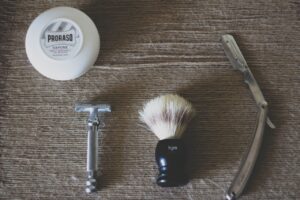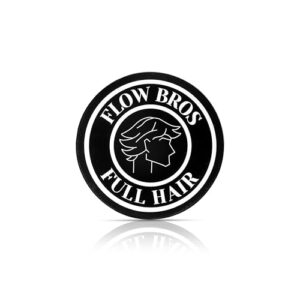Why a Perfect Undercut Starts with a Plan
Master the men’s undercut with clear, practical steps: plan your cut, prep and follow each stage to achieve a clean, modern look, at home or with your barber every time.
What You'll Need
Step 1 — Choose Your Undercut Variant
Think trims are optional? Start wrong and everything looks off—foundation matters.Assess your face shape, hair type, and lifestyle to choose the right undercut variation.
Decide how much contrast you want between sides and top, and factor in hair density, cowlicks, natural parting, and hairline.
Choose one of the following based on your goals:
– Shorter sides for thinning hair (e.g., guard #1–2).
– Higher fade or disconnected look for thick hair.
– Tapered fade for low maintenance and smoother regrowth.
Collect three reference photos showing angle, length, and finish; pick clear clipper guard numbers or top length in inches to avoid miscommunication.
If cutting at home, do a small test section, watch tutorials, and practice clipper control.
Choose faded, tapered, or blunt disconnect finish.
Step 2 — Prepare and Section the Hair
Skip this and you'll look like a teenager—prep makes a pro result.Start with clean, dry hair—damp hair behaves differently and can mislead length decisions. Towel- or blow-dry to remove excess moisture, then comb hair into your natural part.
Clip the top away from the sides using clips, creating a clear border where you won’t cut the sides yet.
Mark your guideline where the undercut will start: low, mid, or high.
Check growth patterns like cowlicks at the crown and around the hairline; if a cowlick pulls hair up, leave extra top length or adjust guard angle. Set yourself up: good prep avoids cutting surprises.
Step 3 — Clip the Sides and Back
Clip with confidence—one guard can make or break your symmetry.Begin with the sides and back using clippers. Start conservatively—use a longer guard at the temples and nape, then blend shorter in stages if you want more contrast.
Hold clippers flat and move against the hair growth; use short upward flicks near the transition to avoid harsh lines.
Work bottom-up for fades, switching progressively to shorter guards and using a comb to blend (for example: #3 at mid, #2 below, #1 at the hairline).
Stop at your guideline for a disconnected undercut and keep that clear length difference.
Finish details around ears and nape with a trimmer for a clean edge.
Step 4 — Shape the Top with Scissors
Scissors are where style lives—shape, don't just cut.Use scissor-over-comb or point-cutting to shape the top. Work in sections from the front to the crown. Lift hair at its natural elevation and trim in small increments to avoid taking off too much. Maintain consistent tension and check weight with your fingers as you cut.
Blend toward the sides by gradually reducing top length if you’ve faded the sides. Cross-check symmetry with both mirrors and by feeling the hair.
Reserve 10–15 minutes to refine layers, soften lines, and create natural movement.
Step 5 — Dry and Style for Texture
Five minutes to great hair? Yes, with the right products.Dry and style to reveal the final shape—wet hair hides texture. Use a blow dryer and a round brush or your fingers to add volume and direction. Aim heat at the roots and lift with the brush or fingers for immediate lift.
Apply a small amount of product—start light and build. Use matte clay/paste for texture; pomade for shine and control. Work product evenly from back to front, focusing at the roots for lift.
Practice daily; most looks take under five minutes. Test products to find the hold and finish that suit your hair and lifestyle.
Step 6 — Clean Up, Blend, and Maintain
Finishing touches separate barbers from beginners—details matter.Refine edges, blend transitions, and polish the look. Keep sentences short and deliberate.
Use trimmers to clean around the ears, sideburns, nape, and neckline—choose a natural tapered finish or a sharper straight line to match the style.
Smudge guard differences with a soft, flicking motion; finish fades with an open blade for crisp lines. Practice on small sections first.
Double-check symmetry: compare side profiles and place small marks at the temples, crown, and nape to ensure consistent length and balance.
Learn basic maintenance: trim the neckline with a straight guideline, tidy sideburns to match, and refresh the fade by blending the mid-area rather than chopping length.
Finish with a light-hold product, inspect in natural light, sleep on a silk pillowcase, and practice quick morning touch-ups.
Step 7 — Aftercare and Barber Communication
Want longer-lasting looks? Maintenance and clear directions are your secret weapons.Maintain your undercut with a simple routine: shampoo two to three times weekly to preserve texture, condition the top, and use lightweight styling products like matte clay or sea-salt spray.
Follow these quick actions:
Finish Strong
Follow these steps to achieve a cleaner, confident undercut—practice, communicate, and maintain it regularly. Try it, share your results, and book touch-ups to keep the look sharp. Get started now!













This guide was solid — especially the part about planning before you touch the clippers.
I messed up my first undercut years ago by skipping the sectioning step and it was a disaster.
Step 3 (clip the sides) and Step 4 (shape the top) being separate really helps when you’re doing it yourself.
Also, shoutout to the aftercare tips — didn’t realize how important the barber convo is for maintenance.
Thanks for the clear steps, saved me a haircut appointment (and cash) this month!
Same — sectioning made it so much easier. I clip the sides then stand back to check balance before touching the top.
Nice! I used a 2 at first, then realized a 1 would’ve been better for the taper. Live and learn 😂
Glad it helped, Ethan — planning really does save a lot of awkward regrowth. If you tried it at home, which guard did you use for the sides?
Good walkthrough. I like the bit on barber communication — too many folks skip that.
One question: when they say ‘shape the top with scissors’, any tips for a beginner so I don’t butcher it?
Also watch a 5–10 minute scissor-over-comb demo on YT. Helps to see the hand motions first.
For beginners: point-cut rather than blunt-cut, use a comb to lift small sections (1cm wide), and work slowly. If you’re unsure, trim a little at a time and check symmetry often.
Couple of quick tips from my experiments:
– Use a longer guard at first and work down gradually.
– When shaping the top, point-cut for texture instead of blunt lines.
– Aftercare: avoid heavy wax for daily use, opt for a light matte product.
These steps pair well with the guide and saved me from a few awkward trims.
I go 3 down to 1.5 depending on how skin-showing I want it to be.
Good list — point-cutting changed my life lol
All solid tips, Benjamin. What guard range do you normally go between for a medium undercut?
I prefer 4 on the sides and then taper — gives a cleaner look without too much contrast.
Funny thing — I tried the ‘finish strong’ styling tips before a date and felt 10x cooler.
That texturizing trick in Step 5 is underrated. Use matte paste, scrunch, and you’re golden.
Only downside: my pillow got jealous of how much product I used 😂
Ha! For pillow marks, try a lighter product or use a sea-salt spray for texture instead of heavy paste at night.
Agreed on the sea-salt spray — gives texture without the crunchy look.
If you’re worried about product buildup, a clarifying shampoo every 1–2 weeks helps.
Also, sleep on a silk pillowcase if you’re that bothered. Less friction and less product transfer.
I appreciate the maintenance section, but: the guide glosses over blending between the top and the fade.
How do you blend without losing the disconnected look some of us prefer?
Feels like a delicate balance and the article could use more tips there.
Also: comb the top forward and clip a tiny bit along the junction, then check from different angles — blending is visual.
Great point. If you want a disconnected look, leave a clear line (don’t fade all the way up). For a blended look, use scissors-over-comb and a clipper guard in between sizes to soften the edge.
I asked my barber to show me the blending process once. Watching helped more than any article for me.
Short and sweet: follow Step 2 and 3 religiously.
If you don’t section first you’re asking for uneven sides. Trust me, learned the hard way.
Totally — sectioning sets up everything else. What clippers did you use?
Wahl Magic Clip — hands down my favorite for home use.
Nice guide. Simple, practical. Followed Step 5 and my hair actually looked like I knew what I was doing for once.
Awesome, Michael — glad Step 5 worked out. What product did you end up using?
Same here, I used a small pea-sized amount of matte paste. Less is more!
I’m here for the sarcasm: ‘Finish Strong’ — as if my hair coopers with strong finishes 😂
On a serious note, the guide is good, but I found the product recs a bit vague. What’s a reliable starter product?
For starters: a light matte paste or clay (e.g., 15–25% hold, low shine) is versatile. Sea-salt spray for volume and texture too. Pick one to experiment with.
I use Baxter of California Clay Pomade — not too heavy, good grip.
American Crew Fiber is another cheap and reliable option for most hair types.
Okay, real talk: this guide is thorough but I wish there were more photos for the sectioning part.
I get the text, but when I tried to section my hair the first time I had no idea where the lines should be.
Maybe a small diagram for ‘short undercut’ vs ‘long top undercut’ would help beginners a lot.
Also the maintenance schedule in Step 6 is great — I literally set a calendar reminder for a trim every 4 weeks.
Please consider adding visuals in the next revision — would make it perfect.
Yes visuals please! I had to pause the tutorial a dozen times to make sure I wasn’t slicing my own ears off 😅
One more tip: take photos of the front and side of a style you like and show them to your barber — helps communicate the exact line you want.
Thanks for the suggestion, Sofia — visuals are on our update list. In the meantime, try a simple guideline: draw an imaginary line from the top of the ear toward the crown for classic undercuts; raise it a bit for a disconnected look.
Agree on the calendar reminder — maintenance saved my last undercut from looking sloppy within two weeks.
If you want a quick DIY, use clips to mark where the side meets the top — gives a visual boundary while you cut.